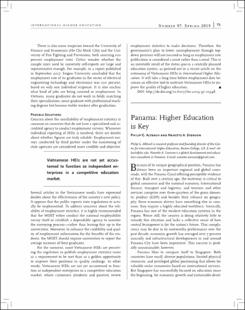| dc.contributor.author | Altbach, Philip G. | |
| dc.contributor.author | Archer Svenson, Nanette | |
| dc.date.accessioned | 2023-12-19T14:20:05Z | |
| dc.date.available | 2023-12-19T14:20:05Z | |
| dc.date.issued | 2019 | |
| dc.identifier.citation | Altbach, P. G., & Svenson, N. A. (2019). Panama: Higher Education is Key. International Higher Education, (97), 23–25. https://doi.org/10.6017/ihe.2019.97.10789 | en_US |
| dc.identifier.uri | https://repositorio.ciedupanama.org/handle/123456789/349 | |
| dc.description | Because of its unique geographical position, Panama has
always been an important regional and global cross roads, with the Panama Canal offering perceptible evidence
of this. Built over a century ago, the waterway is critical to
global commerce and the national economy. International
finance, transport and logistics, and tourism and other
services comprise over three-quarters of the gross domes tic product (GDP) and besides their reliance on geogra phy, these economic drivers have something else in com mon: they require a highly educated workforce. Ironically,
Panama has one of the weakest education systems in the
region. Worse still, the country is doing relatively little to
remedy this situation and lacks a collective sense of how
central brainpower is for the nation’s future. This compla cency may be due to its noteworthy performance over the
past decade; economic growth has averaged over 7 percent
annually and infrastructural developments in and around
Panama City have been impressive. This success is prob ably unsustainable, however. | en |
| dc.description.abstract | Because of its unique geographical position, Panama has
always been an important regional and global cross roads, with the Panama Canal offering perceptible evidence
of this. Built over a century ago, the waterway is critical to
global commerce and the national economy. International
finance, transport and logistics, and tourism and other
services comprise over three-quarters of the gross domes tic product (GDP) and besides their reliance on geogra phy, these economic drivers have something else in com mon: they require a highly educated workforce. Ironically,
Panama has one of the weakest education systems in the
region. Worse still, the country is doing relatively little to
remedy this situation and lacks a collective sense of how
central brainpower is for the nation’s future. This compla cency may be due to its noteworthy performance over the
past decade; economic growth has averaged over 7 percent
annually and infrastructural developments in and around
Panama City have been impressive. This success is prob ably unsustainable, however. | en |
| dc.format | application/pdf | en |
| dc.language.iso | en | en |
| dc.language.iso | en_US | en_US |
| dc.publisher | INTERNATIONAL HIGHER EDUCATION | en_US |
| dc.rights | info:eu-repo/semantics/openAccess | en |
| dc.rights | https://creativecommons.org/licenses/by-nc-nd/4.0 | en |
| dc.subject | Higher Education, Panama | en_US |
| dc.subject | Higher Education, Panama | en |
| dc.title | Panama: Higher Education Is Key | en |
| dc.type | info:eu-repo/semantics/article | en_US |
| dc.type | info:eu-repo/semantics/publishedVersion | en_US |
| dc.type | info:eu-repo/semantics/article | en |
| dc.type | info:eu-repo/semantics/publishedVersion | en |

